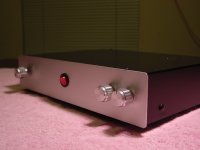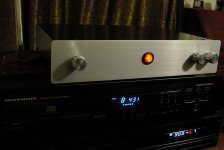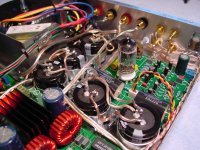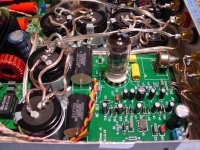right arjen has sent me a delay board which cures the pop at turn on but stil i get the pop at power off !!!!!!! would putting a cap across the power supply help !?!?
How did you manage to get Arjen to send a delay board, I could not even get a reply to my numerous emails sent to him!
BITF
How did you manage to get Arjen to send a delay board, I could not even get a reply to my numerous emails sent to him!
BITF
Me too, but I see now onis_uk´s reply with his concerns about the relay board.
Maybe Arjen will react when the issues are cleared up ...
Hi everyone,
anyone that has an issue with the MKII valve pre-amp can send me a mail at Arjen@helderHIFI.com
Sometimes the mail is stopped by the Chinese fire wall, this is not something i can help. in this case please try arjenhelder@hotmail.com or send me a message on MSN, this cannot fail.
i have now another 6 boards available, the new ones will come in soon also, should be enough to cover the ones that experiences problems.
I'm quite sure in most cases its a case of a poor performing power supply, so i suggest everyone to check this first.
since i want to keep everyone happy the boards are available at no extra cost.
for the ones that need it, please send your current address along in the mail.
Greetings,
Arjen Helder
anyone that has an issue with the MKII valve pre-amp can send me a mail at Arjen@helderHIFI.com
Sometimes the mail is stopped by the Chinese fire wall, this is not something i can help. in this case please try arjenhelder@hotmail.com or send me a message on MSN, this cannot fail.
i have now another 6 boards available, the new ones will come in soon also, should be enough to cover the ones that experiences problems.
I'm quite sure in most cases its a case of a poor performing power supply, so i suggest everyone to check this first.
since i want to keep everyone happy the boards are available at no extra cost.
for the ones that need it, please send your current address along in the mail.
Greetings,
Arjen Helder
About volume control with the buffer. According to Arjen's store, the buffer pot should be used to set the distortion, and then the amp pot to set the volume. This seems strange as I dont want clipping! Isnt it best to use the standard approach of turning the amp pot all the way up (or better removing it), and then using the buffer/preamp pot to control volume? From my view, the only reason to have the amp pot in there is to slightly reduce the amp noise floor for very sensitive speakers.
I was thinking of wiring in one of the MV02 volume controls , either to the buffer input or removing the buffer pot and directly into that position. Anybody replace the buffer pot yet?
I was thinking of wiring in one of the MV02 volume controls , either to the buffer input or removing the buffer pot and directly into that position. Anybody replace the buffer pot yet?
I have been thinking about putting a buffer in front of each 2050 monoblock but don't know; Would you use only one channel(half) of a stereo buffer or would you y in and out of the tube buffer?
I have the first version buffers and they also pop on turn on&off but I just turn them on first and off last.
I have the first version buffers and they also pop on turn on&off but I just turn them on first and off last.
Pops are gone
Hi there,
I have the Tube preamp MKII too, in combination with the TA2020 board and also found the switch on/off pops way too loud, also found 2 volts DC unacceptable for my speakers. Here is what I did to cure it (successfully):
signal flow:
input selector --> volume pot --> input tube preamp/input direct switch --> 10 seconds delayed relais --> TA2020 --> K4700 kit --> speakers
I might be a bit over protected, but works completely pop-less and with no switching hassle.
Here is it in more detail:
1) the inputs are switched with a relais board found on ebay (electronic salon)
2) the signal then goes thru the ALPS pot from Arjen
3) then the signal is fed into the tube preamp. I removed the B choice pot from the tube preamp and replaced it with good fixed resistors (voltage devider that lowers the voltage with 1/3). I also replaced the 2200 Mu cap with a 4700Mu cap on the board.
4) the output signal of the preamp is fed into a miniature relais to A, the direct signal is fed into B of the relais. The common of the relais goes to the TA2020 inputs.
This relais is time delayed with 10 seconds. That is approx. the time needed for the caps to level out the DC voltage at startup of the tube preamp. There is a switch at the front panel that powers the timed circuit of this relais, so I can choose between direct input and tube preamp input. As soon as I choose Tube input, The tube preamp is powered and after 10 seconds the mini relais switches from direct input to tube input.
5) the outputs from the TA 2020 goes trhough the velleman K4700 kit. I only use the time delayed circuit from the K4700 kit and leftout the DC protection circuit for now.
I will try to post some schematics and pictures (still in test modus soon.
soon.
I am still burning in the tube, but the first listening sessions were very promising: wide soundscape and only minor hiss (barely audible at 2 meters from speakers, not audible at listening posistion in a complete silenced room).
Happy soldering & take care!
Yeroen
Hi there,
I have the Tube preamp MKII too, in combination with the TA2020 board and also found the switch on/off pops way too loud, also found 2 volts DC unacceptable for my speakers. Here is what I did to cure it (successfully):
signal flow:
input selector --> volume pot --> input tube preamp/input direct switch --> 10 seconds delayed relais --> TA2020 --> K4700 kit --> speakers
I might be a bit over protected, but works completely pop-less and with no switching hassle.
Here is it in more detail:
1) the inputs are switched with a relais board found on ebay (electronic salon)
2) the signal then goes thru the ALPS pot from Arjen
3) then the signal is fed into the tube preamp. I removed the B choice pot from the tube preamp and replaced it with good fixed resistors (voltage devider that lowers the voltage with 1/3). I also replaced the 2200 Mu cap with a 4700Mu cap on the board.
4) the output signal of the preamp is fed into a miniature relais to A, the direct signal is fed into B of the relais. The common of the relais goes to the TA2020 inputs.
This relais is time delayed with 10 seconds. That is approx. the time needed for the caps to level out the DC voltage at startup of the tube preamp. There is a switch at the front panel that powers the timed circuit of this relais, so I can choose between direct input and tube preamp input. As soon as I choose Tube input, The tube preamp is powered and after 10 seconds the mini relais switches from direct input to tube input.
5) the outputs from the TA 2020 goes trhough the velleman K4700 kit. I only use the time delayed circuit from the K4700 kit and leftout the DC protection circuit for now.
I will try to post some schematics and pictures (still in test modus
I am still burning in the tube, but the first listening sessions were very promising: wide soundscape and only minor hiss (barely audible at 2 meters from speakers, not audible at listening posistion in a complete silenced room).
An externally hosted image should be here but it was not working when we last tested it.
Happy soldering & take care!
Yeroen
And here is the modified schematics for the tube preamp board and the delayed relais!
An externally hosted image should be here but it was not working when we last tested it.
Hi Rich
The output caps are the large red ones, they can be removed if the buffer is feeding into a module that has input caps on it.
Should I replace buffer output caps with wire?
Yesterday I received Helder's buffer I ordered over eBay.
And I wasn't happy with the sound - at all. Lack of bass, and ear-piercing highs.
Just to give it another shot, I went to audio store in my neighborhood, and bought one of JJ's 12au7 (Slovakian). Boy! Everything got much sweeter, and bass improved so much!
This buffer can really do small wonders, but with the right tube, I guess.
If you are buying this buffer, do yourself a favor, and order the buffer WITHOUT a tube. If you can't find some Mullard, RCA or Sylvania in nearby shops - there's hundreds of ppl selling them on eBay.
And I wasn't happy with the sound - at all. Lack of bass, and ear-piercing highs.
Just to give it another shot, I went to audio store in my neighborhood, and bought one of JJ's 12au7 (Slovakian). Boy! Everything got much sweeter, and bass improved so much!
This buffer can really do small wonders, but with the right tube, I guess.
If you are buying this buffer, do yourself a favor, and order the buffer WITHOUT a tube. If you can't find some Mullard, RCA or Sylvania in nearby shops - there's hundreds of ppl selling them on eBay.
Yesterday I received Helder's buffer I ordered over eBay.
And I wasn't happy with the sound - at all. Lack of bass, and ear-piercing highs.
Just to give it another shot, I went to audio store in my neighborhood, and bought one of JJ's 12au7 (Slovakian). Boy! Everything got much sweeter, and bass improved so much!
This buffer can really do small wonders, but with the right tube, I guess.
If you are buying this buffer, do yourself a favor, and order the buffer WITHOUT a tube. If you can't find some Mullard, RCA or Sylvania in nearby shops - there's hundreds of ppl selling them on eBay.
Took your advise and bought some Sylvania JAN 6189 (Military spec 12AU7) on eBay. Read that these are dead quiet from microphonics, also have an RCA black plate (top getter) and an Amperex orange label waiting for the buffers. I am assembling a Helder TA2020 MKIII and a Helder TK2050 with these buffers. Can't wait for them to arrive. Helder's Stacy said they were out of 12AU7 tube stock, so I said ship them without.
I received the tubes, they were not JAN 6189 but plain Sylvania 12AU7, so they went back for the correct ones. Meanwhile I am using an Amperex NOS. Quite smooth.
Finally finished the amp, it consists of 2 Arjen TK2050 monoblocks and the tube buffer.
I made a mistake and bypassed the output capacitors (big reds) on the buffer against Arjen's advice. I should have listened. The sound was brittle, hardly any bass, there was some hiss and the volume pots were scratchy every time you touched them. I was ready to tear the tube buffer out when I decided to put some capacitors that I had from a x-over where the red ones used to be on the buffer. It was the last effort before tearing things up. All the problems above cleared up. No more scratchiness on the volume pots, no hiss, better bass, and the sound is no longer brittle. The result is a very detailed and great sounding amp. Thanks to all the relays on the 2050 monoblocks, there are no pops when on/off. I'll post some pics when I am back on my computer. The capacitors I used are Dayton Precision Audio 4.7 uF / 250 Volts.
Finally finished the amp, it consists of 2 Arjen TK2050 monoblocks and the tube buffer.
I made a mistake and bypassed the output capacitors (big reds) on the buffer against Arjen's advice. I should have listened. The sound was brittle, hardly any bass, there was some hiss and the volume pots were scratchy every time you touched them. I was ready to tear the tube buffer out when I decided to put some capacitors that I had from a x-over where the red ones used to be on the buffer. It was the last effort before tearing things up. All the problems above cleared up. No more scratchiness on the volume pots, no hiss, better bass, and the sound is no longer brittle. The result is a very detailed and great sounding amp. Thanks to all the relays on the 2050 monoblocks, there are no pops when on/off. I'll post some pics when I am back on my computer. The capacitors I used are Dayton Precision Audio 4.7 uF / 250 Volts.
Whaleman:
Does the Arjen tube buffer introduces some noise in the signal??? My TK2050 Monoblocks are almost dead quiet alone.
Not at all, it is dead quiet at idle. You do have more chances of introducing noise in this setup though. You must route all your signal cable away from power supplies and I would braid the signal cables provided with the buffer. Have some girl do it, they are great at it. This keeps the potential of acting like an antenna down. I also only use twisted pair or shielded cable for the signal level cabling, it helps.
Also, you left the buffer output caps in place?
Attachments
Last edited:
Not at all, it is dead quiet at idle. You do have more chances of introducing noise in this setup though. You must route all your signal cable away from power supplies and I would braid the signal cables provided with the buffer. Have some girl do it, they are great at it. This keeps the potential of acting like an antenna down. I also only use twisted pair or shielded cable for the signal level cabling, it helps.
Also, you left the buffer output caps in place?
Whaleman, What kind of case are you using to house the monoblocks, buffer and PSU? Are you powering all of them from the same PSU? Doesn't the buffer require lower voltage?
Whaleman, What kind of case are you using to house the monoblocks, buffer and PSU? Are you powering all of them from the same PSU? Doesn't the buffer require lower voltage?
The Case comes from eBay seller wonderco_buy in Taiwan. It is just tad tight for this setup but it works. It is a blank box, so you must drill your own holes and provide your own knobs, etc.
The buffer and TK2050s run at differing voltages, so I use a dual section Toroidal for the monoblocks and a separate power transformer from Hammond on the tube buffer. These are linear supplies that I built using individual brigde rectifiers and filtering caps. I am not a fan of SMPS just yet. Believe it or not, all fits in the case but there is no room to spare. To me it sounds outstanding.
Yesterday I received Helder's buffer I ordered over eBay.
And I wasn't happy with the sound - at all. Lack of bass, and ear-piercing highs.
Just to give it another shot, I went to audio store in my neighborhood, and bought one of JJ's 12au7 (Slovakian). Boy! Everything got much sweeter, and bass improved so much!
This buffer can really do small wonders, but with the right tube, I guess.
If you are buying this buffer, do yourself a favor, and order the buffer WITHOUT a tube. If you can't find some Mullard, RCA or Sylvania in nearby shops - there's hundreds of ppl selling them on eBay.
I'm using some Hammond silkscreened 12AU7's I bought for about $10 each. They were new old stock, unused (NOS). You can still buy these tubes for not much money here and there ... hopefully that won't change TOO much after this post.
These were either made by Raytheon (up to about 1961) or RCA (afterwards). Mine are dated June 1960, Raytheons from appearance and from the usually reliable sources with regard to whom Hammond bought their tubes from.
The Hammonds are marked with an EIA code of 260, which is incorrect for Raytheon (280). However, at the time, EIA codes were sometimes just lifted and used for OEM-branded output. There is no assigned 260 code for tubes (the EIA codes are component-specific; ie transformers, tubes, etc may have different codes assigned to a manufacturer).
The 260 code points to Philco, but Philco never had a tube fab, the Philco EIA code only applies to Radio and TV sets, and Philco sold it's radios without tubes supplied (much, much later, in the 70's, they used Philco-branded Sylvanias, and are marked with Sylvania's EIA 312, but that was after a corporate merger). The EIA 260 is unassigned for tubes.
Since every other aspect of the tube is consistent with Raytheon, right down to the welds, I'm pretty sure that's what they are. It's not hard to study the construction of a tube by a given manufacturer and identify tubes that way, although subtle differences do matter.
Baldwin screened 12AU7's are the same thing, basically. The organ manufacturers had a tight spec contract with the tube factories (meant paying a premium on the contract), and required that they were individually tested and selected for low noise before they could be branded. All tube factories ground up any tubes that did not meet the standard spec, so there's no chance that there are labeled "seconds" out there.
Broadly speaking these are the better units from production that were selected at the factory before going to silkscreen. Because of the contract, the organ companies could return any units that didn't meet the tighter spec, so care was taken by Raytheon/RCA to avoid having tubes rejected.
I would expect that any organ-branded tubes would be tighter than ordinary production, although that doesn't mean ordinary production wouldn't meet that spec either, it's just that only some of them would. Might be worth remembering if you need other tube types.
Sounds very good in the buffer. I bought one and a spare, and considering the tube life of this type can go beyond 10,000 hours, I would suggest to anyone to just get a decent tube (or a pair) and run with it.
I ran the board in with the Hammonds before any mods, and it sounded good as is. I've since replaced the 0.47uf caps with WIMA MKP10 160/100V and the 2.2uf's with the basic Mundorf M-caps @ 250V, and gone to a SMD-constructed 31-pos resistive attenuator. The caps don't fit easily in the space on the board, just so everyone knows. I'm done with the mods, though ... works wonders driving a T-amp board, no question.
Last edited:
Awsome with the Electo-Harmonix & his TK2050s
Bought a set of Helder's TK2050 and the tube buffer. I replaced the stock tube with a regular Electro-Harmonix version.
The TK2050s by themselves sound just like a typical T-amps. However, couple them with his buffer and the Electro-Harmonix tube, they sound amazing. Much more pleasant, and the strange thing is that the imaging becomes razor sharp.
To get rid of the buffer pop, add more filter caps to the buffer supply, so the TK2050 relays cut off the speakers before the buffer supply runs out of juice.
Bought a set of Helder's TK2050 and the tube buffer. I replaced the stock tube with a regular Electro-Harmonix version.
The TK2050s by themselves sound just like a typical T-amps. However, couple them with his buffer and the Electro-Harmonix tube, they sound amazing. Much more pleasant, and the strange thing is that the imaging becomes razor sharp.
To get rid of the buffer pop, add more filter caps to the buffer supply, so the TK2050 relays cut off the speakers before the buffer supply runs out of juice.
- Status
- This old topic is closed. If you want to reopen this topic, contact a moderator using the "Report Post" button.
- Home
- Amplifiers
- Class D
- Arjen Helder Buffer V2



